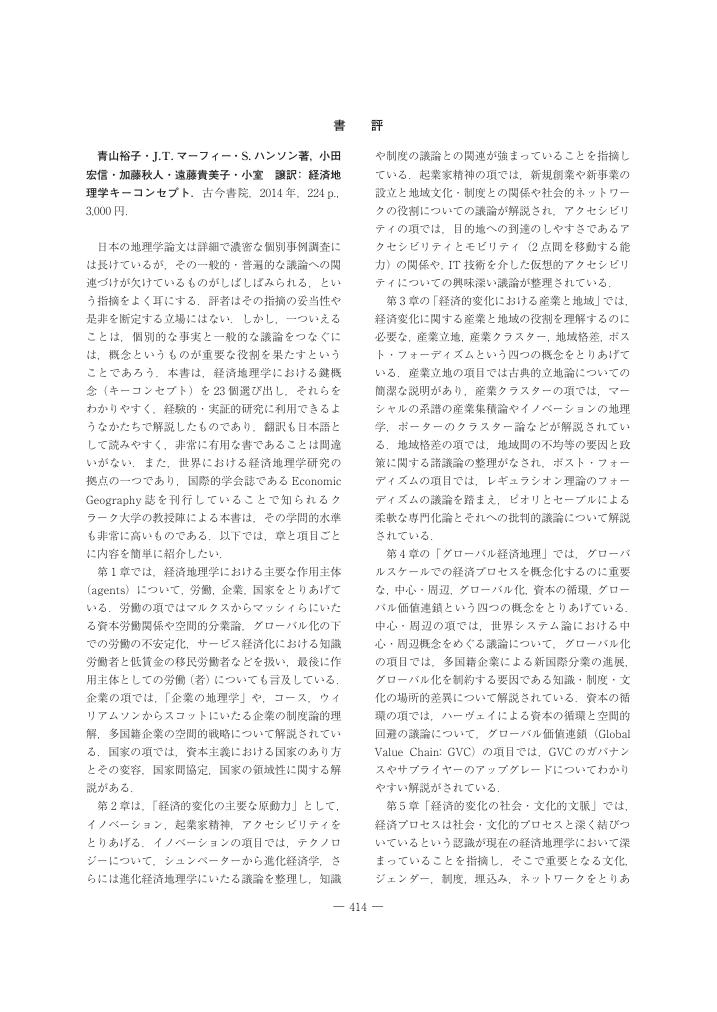- 著者
- 水野 真彦
- 出版者
- 経済地理学会
- 雑誌
- 経済地理学年報 (ISSN:00045683)
- 巻号頁・発行日
- vol.59, no.4, pp.454-467, 2013-12-30 (Released:2017-05-19)
- 被引用文献数
- 1
本稿は,この20年ほどの経済地理学の動向をもとに,制度・文化的視点とネットワーク的視点を取りあげ検討し,経済地理学の本質について考える材料とすることを目的とする.まず制度・文化的視点について,特に国もしくは地域など領域の形態をとって現れる制度・文化に焦点をあて,その論点を整理した.次に,領域を越える企業や社会的つながりを強調するネットワーク的視点に注目し検討した.そのうえで,それらを包含する近年の経済地理学の傾向を,企業や個人などアクターの相互関係に焦点を当てる関係論的視点とし,それが今後の方向性として有力なものであることを論じた.
3 0 0 0 OA 経済地理学における社会ネットワーク論の意義と展開方向 -知識に関する議論を中心に-
- 著者
- 水野 真彦
- 出版者
- The Association of Japanese Geographers
- 雑誌
- 地理学評論 (ISSN:13479555)
- 巻号頁・発行日
- vol.80, no.8, pp.481-498, 2007-07-01 (Released:2010-03-12)
- 参考文献数
- 81
- 被引用文献数
- 8 6
本稿は, 経済地理学において知識の問題を議論する際に, 社会ネットワーク論の視点が有効であることを指摘し, その展開方向について整理した. 社会ネットワーク論においては, 対象はアクターの関係のネットワークとしてとらえられ, 結合の内容やネットワークの構造が, アクターの行為に影響を与えると考える. 知識の移転・学習におけるアクターの多様性・流動性の意義の問題は, 社会ネットワーク論の視点からは, アクターの結合の質やネットワークの構造の問題ととらえることができる. 具体的には, 弱い紐帯, ブリッジの存在, ランダムで偶然な結合の形成が, 新しい有用な知識の流通を促すと考えられる. そのような社会ネットワーク論においては空間性は考慮されていないため, 経済地理学においてはアクター間の近接性に焦点を当てる必要がある. ただし, この場合の近接性とは, 地理的近接性だけではなく, 組織的近接性や制度的近接性も含まれ, それらは相互に関連している.
3 0 0 0 OA 企業間ネットワークにおける技術的イノベーションと地理的近接との関係
- 著者
- 水野 真彦
- 出版者
- The Association of Japanese Geographers
- 雑誌
- 地理学評論 (ISSN:13479555)
- 巻号頁・発行日
- vol.77, no.13, pp.940-953, 2004-11-01 (Released:2008-12-25)
- 参考文献数
- 31
- 被引用文献数
- 4 2
本研究は,大阪府における中小企業のネットワークと技術的イノベーションの地理的側面について特許のデータを用いて考察したものである.大阪府の中小企業が他の企業と共同で生み出した発明を特許の共同登録のデータから把握し,両者間の地理的距離と企業の属性との関係を検討した.その結果,共同発明を行った相手は,同じ大阪府内の企業あるいは組織である割合が高いことが示された.規模が小さく,若い企業は,近接した企業と共同で発明を生み出すという傾向が非常に弱いながらも見出せた.一方,産業部門により相手との距離は異なる.具体的には,金属・プラスチック製品などの中小企業間の域内ネットワーク,電気機械や家具などの大企業と中小サプライヤーの域内ネットワーク,大阪府の中小一般機械メーカーと域外の大企業とのネットワークなどを典型とする多様なネットワークから発明が生み出されていることが確認された.
- 著者
- 水野 真彦
- 出版者
- 一般社団法人 人文地理学会
- 雑誌
- 人文地理 (ISSN:00187216)
- 巻号頁・発行日
- vol.62, no.5, pp.426-444, 2010 (Released:2018-01-19)
- 参考文献数
- 109
- 被引用文献数
- 2
This paper reviews studies focused on the economic and social restructuring of cities in developed countries in the 2000s (2000-2009) from the viewpoint of economic geography. Drawing on critical examinations of the global cities thesis and the creative class thesis by Saskia Sassen and Richard Florida, respectively, the author points out the following four features of urban restructuring during the decade.First, urban spaces that contain land and buildings have gradually been incorporated in global financial capitalism. In other words, they have become financial products that have been traded beyond local and national borders, which caused a growth in financial business and a rapid rise in housing prices and rent prior to the financial crisis. The surge of financial capitalism in the 2000s has had a tendency to destabilize urban spaces and the lives of the residents in these areas.Second, neo-liberal policy movements have emphasized intensifying intercity competition and the rise of urban entrepreneurialism. City governments increasingly tend to pay more attention to attracting mobile capital, and neglect social policy for city residents, who are relatively immobile.Third, according to Sassen, global cities are characterized by the economic and social polarization of urban residents. In the 2000s, many Japanese writers and researchers discussed the fact that Japan had been converted into a gap-widening society. The increasing job insecurity of younger workers is suggested as a cause of the widening of the income gap. In particular, some critics perceive the suburbs as a problem, partly because irregular and low-paid employment is often a feature of these regions. In addition, this decade has witnessed an increase in the regional disparity between Tokyo and the rest of Japan.Fourth, the intercity competition for attracting highly skilled talents has been accelerated in the 2000s. Richard Florida insists that attracting the creative class is fundamental to urban development. He suggests that diversity, openness, and tolerance are magnets that attract the creative class. Although his view has drawn the attention of local politicians and policymakers, a considerable number of scholars criticized it for several reasons. One of these criticisms is that urban development can be better explained in terms of locations that offer job opportunities rather than the residential preferences of people or urban amenities. Another criticism is that urban policies based on Florida’s view possibly deepen the social divide between the creative class and the rest of the population. We have to recognize the importance of job creation in production activities throughout the production chains in order to prevent the deepening of the social divide in urban societies.
- 著者
- 水野 真彦
- 出版者
- 公益社団法人 日本地理学会
- 雑誌
- 地理学評論 Series A (ISSN:18834388)
- 巻号頁・発行日
- vol.92, no.6, pp.412-413, 2019-11-01 (Released:2022-09-28)
- 著者
- 水野 真彦
- 出版者
- 公益社団法人 日本地理学会
- 雑誌
- 地理学評論 Series A (ISSN:18834388)
- 巻号頁・発行日
- vol.87, no.5, pp.414-415, 2014-09-01 (Released:2019-10-05)

